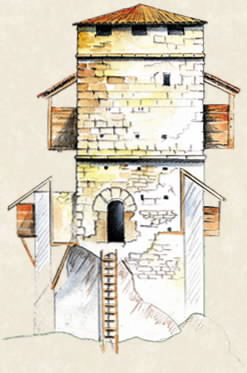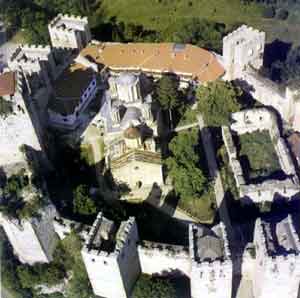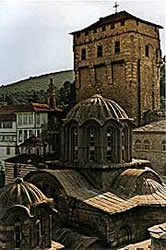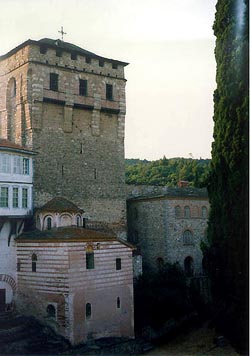 PYRGOS–STL’P–DONJON.A WESTERN FORTIFICATION CONCEPT ON MOUNT ATHOS, AND ITS SOURCES
PYRGOS–STL’P–DONJON.A WESTERN FORTIFICATION CONCEPT ON MOUNT ATHOS, AND ITS SOURCES
Slobodan Curcic (University of Illinois, Urbana-Champaign)
Late Byzantine monastic fortifications are distinguished by the presence of single dominant towers –pyrgoi (sing. pyrgos in Greek; stl’p in Old Church Slavonic). Their affinities with western medieval fortification towers–donjons–have been noted, while the Crusades have been considered the means by which this western fortification concept reached the Byzantine world. The entire matter is far from being fully understood and deserves considerable further study.
The fortification towers of Hilandar Monastery on Mount Athos represent a coherent group and offer some valuable insights regarding the chronology and sources of a specific tower type. This type is distinguished by pronounced pilasters, or spur walls which articulate all four tower facades and rise nearly the full height of the building. At the top, these are joined to each other by large arches which, in turn, support a gallery on the top floor.No less than five towers of this type survive within the system of Hilandar defenses. Two–the Tower of Sv. Sava and the Tower of Sv. Djordje (St.George)–belong to the fortification walls of the monastery itself. The Tower of Sv. Vasilije (St. Basil) belongs to a small fortified outpost which once protected the harbor of Hilandar. Two additional towers–“Pirg kralja Milutina”(the Tower of King Milutin), and “Arbanaûki pirg” (the AlbanianTower)–constituted detached fortified stations whose function was to control strategic points on the approach paths to the monastery. The Tower of St.Sava (specifically, its lowest portion), is the oldest of the five towers,dating probably from ca. 1200. The tower was extensively restored, most likely at the time of King Milutin’s reconstruction of the monastery. The tower of St. George may be from the middle of the thirteenth century. The remaining three towers are generally attributed to King Milutin. The five towers display design similarities which prompted some scholars to refer to the type asthe “typical Athonite tower.” The fact of the matter is that a very limited number of Athonite towers share these design characteristics.
 Searching for prototypes, we find that very few such towers are to be found elsewhere in the Balkans. Foundations of one were excavated in front of the main entrance into Banjska Monastery, and may be attributed safely to King Milutin. The finest of all examples is located in Rila Monastery,Bulgaria. It was built in 1335, by one Hrelja, a high-ranking official ofthe Serbian king Stefan Duûan. The relative geographic and chronological coherence of all of these towers suggests that they may have been the work of the same workshop or, at the very least, that they belong to the same building tradition which was imported into this area. The basic concept of these towers, as well as their formal articulation, is foreign to
Searching for prototypes, we find that very few such towers are to be found elsewhere in the Balkans. Foundations of one were excavated in front of the main entrance into Banjska Monastery, and may be attributed safely to King Milutin. The finest of all examples is located in Rila Monastery,Bulgaria. It was built in 1335, by one Hrelja, a high-ranking official ofthe Serbian king Stefan Duûan. The relative geographic and chronological coherence of all of these towers suggests that they may have been the work of the same workshop or, at the very least, that they belong to the same building tradition which was imported into this area. The basic concept of these towers, as well as their formal articulation, is foreign to
– 22 –
Byzantine fortification architecture in general. Instead, their source appears to have been fortification architecture of twelfth and thirteenth-century France. A group of French donjons of this period displays the same basic planning characteristics, similar dimensions, and the same subtle variations in the articulation of facades as the Hilandar group of towers (cf. donjons at Chervix, Saugues, Chevreuse, La Roche-Posay, Abbeville, Eschizadour, and Saint-Genies).
Links with France are better understood if one is reminded that King Milutin’s mother Jelena (Helen) was a French royal princess. As the Dowager Queen,Jelena ruled over the coastal region of the Serbian state. From there she maintained friendly relations with Italian towns on the other side of the Adriatic sea (most notably with Bari), and with the Papacy. On Topaona island in the Skadar Lake, within Jelena’s domain, are located impressive remains of a tower, referred to in literature as belonging to the “Athonite tower type.” In this important example, I believe, we have the actual link between the French donjons and the towers of Hilandar. Taking all of the above information into account, we may conclude that the large monastic towers of Mount Athos, built toward the end of the thirteenth and during the first decades of the fourteenth century, were French donjons transplanted into the monastic milieu of the Holy Mountain under the patronage of King Milutin.

Hilandar Monastery’s fortifications 

Saint Savoy’s Tower, part of the French donjon fortifications,
Hilandar Monastery, Mt Athos
Paper above (but not all these photographs) is from the Seventh Annual BYZANTINESTUDIES CONFERENCE, 13-15 November 1981
Boston University, Boston, Massachusetts ABSTRACTS OF PAPERS
Retrieved From http://www.byzconf.org/1981abstracts.html 1-15-07

